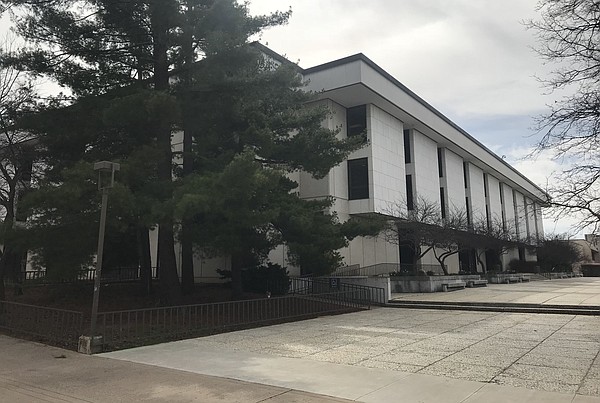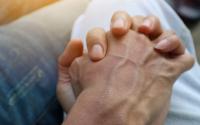
FAYETTEVILLE — “Americans and the Holocaust: A Traveling Exhibition for Libraries” will open next week at the David W. Mullins Library, the only time the exhibit will be in Arkansas during its tour of the country.
The exhibit is stopping in only 50 locations, and the University of Arkansas campus in Fayetteville was selected as the spot for Arkansas, said Kara Flynn, education and engagement archivist, Special Collections, University Libraries at UA-Fayetteville.
The exhibition is an educational initiative of the United States Holocaust Memorial Museum in Washington, D.C., and the American Library Association, a national organization that’s been providing resources for library and information professionals to transform their communities through programs and services. More information can be found online at https://bit.ly/3sYuXZh.
It’s the “traveling version of an exhibit” created at the Holocaust Memorial Museum in 2018 and “gives people a chance to have that experience even if they never get to go to Washington,” Flynn said. The exhibit at the museum in Washington helped inspire “The U.S. and the Holocaust,” a film by Ken Burns, Lynn Novick and Sarah Botstein that premiered on PBS earlier this year.
“We decided it was really important to create a travel version of this for people who can’t make it to [Washington], because this ties together American history and Holocaust history in a way that can really speak to the American public,” said JoAnna Wasserman, education initiatives manager at the William Levine Family Institute for Holocaust Education, United States Holocaust Memorial Museum. “This is not [focused on] Europe, but what was happening here.”
The traveling exhibit “covers a lot of the content and big events of the Holocaust and World War II people may be familiar with, but the lens is reactions and responses from Americans” to Nazism, war and genocide in Europe during the 1930s and 1940s, Flynn said. The exhibit “is about posing questions and promoting critical thinking and discussions, not conclusions.”
It considers the myriad factors that shaped American response, from a philosophy of isolationism to the strain of the Great Depression to restrictive immigration laws that had been on the books for decades, she said. It also highlights the individuals and groups who did try to help refugees, although “unfortunately there were too few.”
Roughly 6 million Jews were murdered during the genocide by Nazi Germany and its collaborators, but Romani people, Poles, Ukrainians, Soviet civilians and prisoners of war, Jehovah’s Witnesses, Black people, people with disabilities, communists and gay individuals were also targeted in the systematic mass killing.
The exhibition opens Thursday and will be on display through Dec. 8 at Mullins Library, the main research library for the university and the largest library on campus.
Bringing this exhibition to Arkansas is critical, because “our state hasn’t historically had the strongest Holocaust education,” Flynn said. In fact, only in the spring of 2021 did the Arkansas Legislature pass a bill requiring Holocaust education in public schools.
Individuals can access the exhibition on their own or take guided tours, she said. The exhibit will be open nightly until 6 p.m. and each morning according to Mullins Library hours — which can be found online at https://libraries.uark.edu/hours/mullins.php — while tours can be arranged at https://uark.libguides.com/AATH. The latter website also has additional companion materials, such as resource guides for teachers, Flynn said.
Interactivity is a highlight, including maps and timelines, but also access to newspapers from various states from the 1930s and 1940s, she said. Visitors can see how the Holocaust, World War II and other events in Europe were covered in the U.S.
The examples of news coverage from each state from the era covered by the exhibition “is a big takeaway,” as are the individual stories, Wasserman said.
The exhibit also provides public polling data from the time period, Flynn said. “You can see how Americans were responding — what they thought — at that time.”
The original exhibit at the museum in Washington was informed by “lots of new research,” which is also key to the traveling exhibition, Wasserman said. “We learned a lot about what information was available at that time, and we’re trying to correct some misconceptions.”
For example, “the assumption that most Americans had no idea what was happening [in Europe] is not true,” she said. “If you were paying attention, you knew, but we were a very isolationist country at that time.”
Previously, exhibits like this would stop mostly at museums, but public and campus libraries are the focus this time, she said. “We wanted to take it where there might be more exposure and to places that people might go for other reasons,” because the goal is to reach “audiences that may be underserved by Holocaust education.”
More than 250 sites applied to host the exhibition, said Jason Battles, dean of University Libraries, in a news release.
Entities that wanted to host the exhibition had to “fill out an extensive application” about why they should be selected, as well as outlining shoulder programming, Wasserman said. The exhibit itself, as well as events in conjunction with it, have already led to “a lot of connections being made in communities.”
Communities and individuals are connecting the story of the Holocaust with modern genocide, as well as the need to aid refugees from places like Ukraine, she said. By highlighting stories of individuals who tried to help during the Holocaust, the exhibit is a reminder of the power of the individual.
Hosts for the exhibit have been asked by the American Library Association to offer local, companion programming.
When the exhibit went to Hawaii, that state also offered resources and information about the attack on the Pearl Harbor naval base that led to America’s declaration of war against Japan — and its official entry into World War II.
In Arkansas, supplemental information is geared toward Japanese-American incarceration camps, documenting experiences of those individuals, she said. There were two such camps in Arkansas during World War II, and the World War II Japanese American Internment Museum — a part of the Arkansas State University Heritage Sites Office — is in McGehee.
There will be an opening reception at Mullins Library on Thursday from 4:30-6:30 p.m. and a film screening of “Prelude to War” — a film directed by Frank Capra and aimed to rally support for American intervention in World War II — at 7 p.m. Nov. 16 at the Pryor Center for Arkansas Oral and Visual History, said Kelsey Lovewell Lippard, director of public relations, University Libraries. There will also be a panel discussion about the Holocaust in the library from 5:30-6:30 p.m. Dec. 1, and a guest speaker will share her family’s World War II experiences at 6 p.m. Dec. 7 in the Fayetteville Public Library.
Laurence Hare, UA-Fayetteville associate professor of history and director of the International & Global Studies Program, will deliver remarks at 5:15 p.m. during the opening reception, while Frank Scheide, professor of communication, will lead the screening of “Prelude to War” and a discussion about the film, according to the university.
In addition, the Springdale Public Library will host a free public forum Sunday at 1:30 p.m. titled “The U.S. and the Holocaust: Immigration Then and Now,” in partnership with Arkansas PBS and the Arkansas Holocaust Education Committee. The event will feature selected clips from “The U.S. and the Holocaust,” as well as a discussion “emphasizing issues such as xenophobia, antisemitism, immigration quotas,” etc.








